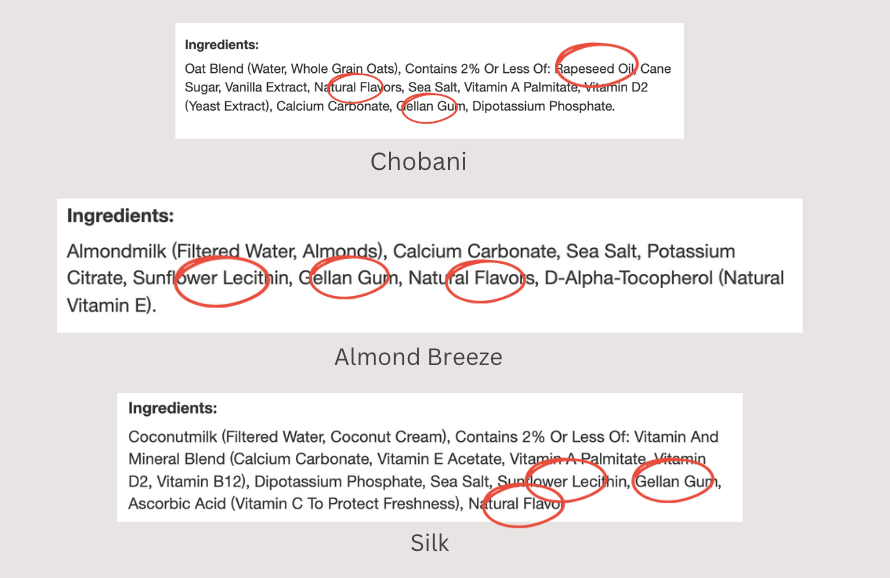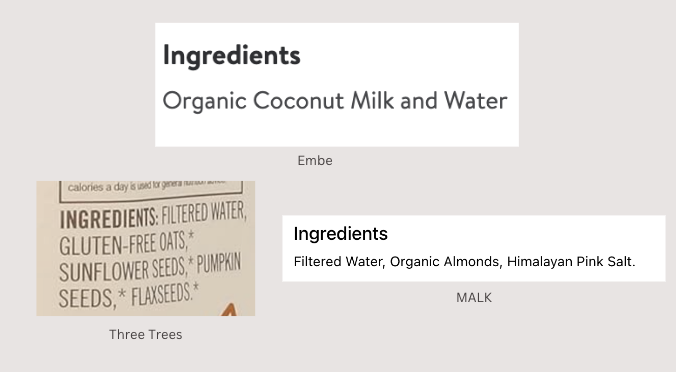Safer Plant Based Milk
- Alex Kelly
- Jul 19, 2024
- 6 min read
Updated: Apr 16
What to Avoid
Gums (i.e guar, gellan, xanthan, locust bean gum
Oils (i.e rapeseed oil aka canola oil)
Emulsifiers (sunflower lecithin)
Natural Flavors
Sweetened
“Original” if it’s not also labeled “unsweetened”
Gums: These are used to prevent separation, extend shelf life, and thicken the consistency. Many of these gums have been shown to cause GI issues. Guar gum has been associated with small intestinal and esophagus obstruction (1). Xanthan gum has been associated with laxative effects in adults, and appears to be unsafe and contraindicated for infants (2).
Oils: These are used in order to boost the fat content in plant-based milks (especially oat) so that they don’t have to use as many oats/nuts/etc., in order to bring their costs down. One of the most common oils you will see is low erucic acid rapeseed oil. This is another word for canola oil, which is typically genetically modified and highly inflammatory.
Emulsifiers: One of most common emulsifier you will see in plant-based milk is sunflower lecithin. This is used to help combine the different ingredients together with water. Sunflower lecithin does contain fatty acids, phospholipids, and vitamins, and at times can be used to help balance cholesterol levels, promote absorption of soluble nutrients, and aid in digestion. It can also support breastfeeding mothers. However, excessive lecithin can lead to increased levels of choline, which can overstimulate the nervous system and lead to nausea, diarrhea, vomiting, sweating, headaches, and dizziness. So, while not inherently bad just be mindful of how you are feeling if plant-based milk is something you drink a lot of on a daily basis. Some people have no reactions, others may be more sensitive.
Natural Flavors: The FDA doesn’t require food labels to disclose what’s in their “natural flavors,” unless the ingredients include a common allergen. When you see “flavor” listed as an ingredient, it is actually a recipe that may be compromised of upwards of 100 ingredients. For example, “natural apple flavor” may have been preserved and stabilized with chemical agents added to help it mix into the product such as propylene glycol, BHT, BHA, and polysorbate 80 (3). However, this isn’t always the case. Sometimes natural flavors may, indeed, be fully natural and non-toxic but the company wishes to not release their “secret ingredient” in order to protect themselves from replicas. So, it’s best to stay away from this ingredient unless you have heard directly from the company and trust their transparency.
Sweetened: This one is pretty self explanatory and means the milk has been sweetened with extra added sugar. The most common flavor you’ll see is vanilla. For example, Almond Breeze’s Vanilla contains 13g of sugar vs 7g in their Original, and 0g in their Unsweetened.
Original: Many people think that “original” means unsweetened or no sugar. This is not the case. Almond Breeze’s Original contains 7g of added sugar, where as their “Unsweetened Original” contains 0g of added sugar.
What to Look For
Simple, plain as possible ingredients.
Safer Options to Consider
Peace, Rice, & Soy
Peace & Rice Milk
Commonly high in heavy metals, especially arsenic. If you choose these milks I would advise reaching out to the company and ask if they have a heavy metal testing process.
Soy Milk
Many studies point towards soy actually helping reduce breast cancer, amongst other benefits. However, there’s also some conflicting research. While I have found more positive than negative research, I typically don’t like to blanket recommend it since it’s benefits potentially depend on each individuals health situation. Soy is also high in Omega-6s, which if over-consuming can lead to inflammation. Also, keep in mind, most soy grown in the US is genetically modified. So if you’re going to choose this milk I would look for one that is labeled “non-GMO” or “Organic.”
Lactose Free Milk: do you really need it?
True Lactose Intolerance
Lactose intolerance is caused by the inability to breakdown lactose, which is the form of sugar found in milk (including breastmilk). Typically a true lactose intolerance is due to a genetic condition where a person does not produce the lactase enzyme needed to breakdown lactose. A baby who is truly lactose intolerant would fail to thrive right off the bat, and show other signs of malabsorption and dehydration from birth. It is extremely uncommon for someone without this genetic condition to be lactose intolerant.
Secondary Lactose Intolerance
There is such thing as “secondary lactose intolerance.” This is when irritation or damage to the gut lining can impair the production of lactase. In these cases avoiding lactose acts as a band-aid, it will not solve the underlying problem. In these cases, the health of the gut must be addressed.
Other conditions that may effect the production of lactase include gastroenteritis and parasitic infections. Premature babies also may not make enough lactase for a short time after birth.
How to Test for Lactose Intolerance
Genetic Testing - This test uses DNA from blood samples amplified and digested with restriction enzymes. The pattern of DNA fragments is then used to indicate if a person is lactose intolerant or not.
Hydrogen Breath Test - You will drink a liquid that contains a certain amount of lactose, and every 30 minutes over the course of a few hours you breathe into a balloon-like container that measures the amount of hydrogen in your breath. If your breath hydrogen levels rise AND symptoms get worse during the test, you may be diagnosed as lactose intolerant.
Stool Acidity Test - It is very difficult to perform a hydrogen breath test on a baby, so often times a stool acidity test will be done to measure the lactic acid, glucose, and other fatty acids.
Dairy Free Milk: do you really need it?
Milk Allergy
A milk allergy is the reaction to the protein in milk. In these cases the immune system reacts as though the protein is a dangerous invader to the body. Because of the rarity of true lactose intolerance, either secondary lactose intolerance due to gut inflammation or a milk allergy is most likely going to be the cause of symptoms.
What many people don’t realize is that not all animal milk protein is the same. If someone truly has an allergy to cow milk protein, they typically have no problems with goat milk - which is easier on the digestive system, and a much better option than most lactose free options.
Why Goat Milk?
Compared to cow milk, goat milk forms a smaller, softer, and looser curd in the stomach which makes digestion quicker and easier. The fats in goat milk are also easier to digest, because they are smaller than cow milk fats.
Goat milk contains more gut-supportive prebiotic oligosaccharides, and has superior mineral bioavailability. It also contains a considerably lower amount of A1 casein protein, which is the most inflammatory casein protein. Many people who have a “dairy allergy,” actually have an A1 casein milk-protein allergy or secondary lactose intolerance due to inflammation - because of this many are able to handle goat milk just fine. Goat milk is a great option for anyone, but especially those suffering from stomach issues, eczema, recurrent ear infections, reflux, and chronic nasal congestion.
How to Test for a Milk Allergy
Skin Test - This is when the skin is pricked and exposed to small amounts of protein found in milk. If an allergy is present, a raised bump (hive) will appear. However, this test isn’t completely accurate.
Blood Test - This test measures the immune system’s response to milk by measuring the amount of immunoglobulin E (IgE) antibodies in the blood. This test, also, isn’t completely accurate.
Oral Challenge - The medical professional will provide different foods that may or may not contain milk in increasing amounts. They will then observe if you react to the ones that contain milk.
Elimination Diet - This is when the provider will advise the elimination of all dairy from your diet to see if symptoms subside. However, this test can be unreliable because many times symptoms will subside because the over-processed dairy that is widely available is no longer being consumed, decreasing inflammation - giving the false sense that it was due to an allergy and not inflammation due to the junk filled milk.
Sources:
1 Lewis JH. Esophageal and small bowel obstruction from guar gum-containing "diet pills": analysis of 26 cases reported to the Food and Drug Administration. Am J Gastroenterol. 1992 Oct;87(10):1424-8. PMID: 1329494.
2 Daly J, Tomlin J, Read NW. The effect of feeding xanthan gum on colonic function in man: correlation with in vitro determinants of bacterial breakdown. British Journal of Nutrition. 1993;69(3):897-902. doi:10.1079/BJN19930089












Comments